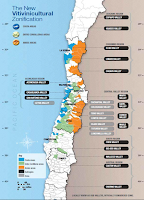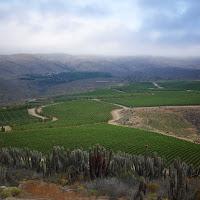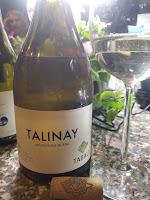 The Limarí Valley is one of the northernmost wine-growing regions in Chile, located 200 miles (320km) north of the capital, Santiago. Technically, Limarí (Lee-ma-RE) is not a valley, but a high plateau (“altaplana” in Spanish). It is also closer to the equator and thus hot and dry but contains areas suitable for viticulture thanks to its close proximity to the Pacific (seven miles) and to the gap in the coastal hills created by the Limarí River. On either side of this gap, the coastal ranges rise to almost 2300ft (700m), preventing cooling Pacific breezes from reaching inland areas.
The Limarí Valley is one of the northernmost wine-growing regions in Chile, located 200 miles (320km) north of the capital, Santiago. Technically, Limarí (Lee-ma-RE) is not a valley, but a high plateau (“altaplana” in Spanish). It is also closer to the equator and thus hot and dry but contains areas suitable for viticulture thanks to its close proximity to the Pacific (seven miles) and to the gap in the coastal hills created by the Limarí River. On either side of this gap, the coastal ranges rise to almost 2300ft (700m), preventing cooling Pacific breezes from reaching inland areas.  In the morning, the coastal "Camanchaca" fog creeps through the gap and up into the valley. The fog refreshes the local vineyards with cool, moist air, and once it dissipates it is replaced by cooling breezes from the cold Humboldt Current (See Grape Spotlight: Casablanca Valley Sauvignon Blanc about the cooling effects of the Humboldt Current). Once the sun has risen above the Andes the warm, dry, desert-like conditions are re-established. And in the afternoon, "the wind coming from the Andes can be so strong that some producers plant their rows east-west so that the vines don’t take the brunt of the powerful wind head-on".
In the morning, the coastal "Camanchaca" fog creeps through the gap and up into the valley. The fog refreshes the local vineyards with cool, moist air, and once it dissipates it is replaced by cooling breezes from the cold Humboldt Current (See Grape Spotlight: Casablanca Valley Sauvignon Blanc about the cooling effects of the Humboldt Current). Once the sun has risen above the Andes the warm, dry, desert-like conditions are re-established. And in the afternoon, "the wind coming from the Andes can be so strong that some producers plant their rows east-west so that the vines don’t take the brunt of the powerful wind head-on".  The soils in the Limari Valley are quite unique for Chile as they consist of limestone from an ancient seabed that was raised by tectonic activity into the Andes Mountains. The limestone was then gradually washed downstream by glaciers and rivers to the plains and valleys below. A great source of calcium carbonate.
The soils in the Limari Valley are quite unique for Chile as they consist of limestone from an ancient seabed that was raised by tectonic activity into the Andes Mountains. The limestone was then gradually washed downstream by glaciers and rivers to the plains and valleys below. A great source of calcium carbonate.Viña Tabalí was founded in 2002 by Guillermo Luksic and was the first modern winery built in the Limarí Valley. However, his foray into Limari started a decade before when he purchased the Tabalí vineyard because "I want to have land in Ovalle because it’s a fascinating area with its climate and temperature and it’s also very pretty". In 2009 the winery acquired the Talinay Vineyard located next to the Fray Jorge National Park and which forms part of the UNESCO World Biosphere Reserve. It is located only 12km from the coast and is the source for the Viña Tabalí Talinay Sauvignon Blanc 2021 ($24). According to the winery,
This is a very unusual landscape, as it is completely unpopulated. It adjoins the Fray Jorge National Park and forms part of the UNESCO World Biosphere Reserve. The proximity to the sea and the entry of sea breezes make this a cool area for producing wines. It is very cloudy in the mornings and the camanchaca sea fog effect kicks in in the afternoons. The dense fog settles in the high parts of the Altos de Talinay hills and gives life to the forest of Fray Jorge. This mist produces average annual precipitation of 1,000 mm on the western face of the hills. This is a very windy area and the sea breezes cross through the clouds, lowering the temperature even further and making this the coolest vineyard in the whole 4th Region of Chile. The wind also carries evaporated components from the sea to the vineyards. This is an oasis in the desert, which receives 80mm of rain a year and is sparsely vegetated with cacti, small bushes and gentle slopes. The landscape shows the Coastal mountain range to the west and a small chain of hills to the east, making this place a small hidden valley. To the south, the vineyard borders the River Limarí. It is the last water right holder of the valley, that is the one nearest to the ocean (12km).
The wine was cold fermented in stainless steel and is completely saline driven from head to toe. White flowers and lime notes accompany the minerality in the nose whereas the saline shares the palate with just a touch of citrus. A fresh finale.
